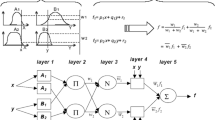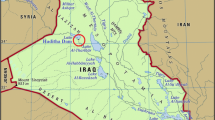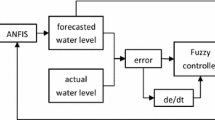Abstract
Existing forecast models applied for reservoir inflow forecasting encounter several drawbacks, due to the difficulty of the underlying mathematical procedures being to cope with and to mimic the naturalization and stochasticity of the inflow data patterns. In this study, appropriate adjustments to the conventional coactive neuro-fuzzy inference system (CANFIS) method are proposed to improve the mathematical procedure, thus enabling a better detection of the high nonlinearity patterns found in the reservoir inflow training data. This modification includes the updating of the back propagation algorithm, leading to a consequent update of the membership rules and the induction of the centre-weighted set rather than the global weighted set used in feature extraction. The modification also aids in constructing an integrated model that is able to not only detect the nonlinearity in the training data but also the wide range of features within the training data records used to simulate the forecasting model. To demonstrate the model’s efficacy, the proposed CANFIS method has been applied to forecast monthly inflow data at Aswan High Dam (AHD), located in southern Egypt. Comparative analyses of the forecasting skill of the modified CANFIS and the conventional ANFIS model are carried out with statistical score indicators to assess the reliability of the developed method. The statistical metrics support the better performance of the developed CANFIS model, which significantly outperforms the ANFIS model to attain a low relative error value (23%), mean absolute error (1.4 BCM month−1), root mean square error (1.14 BCM month−1), and a relative large coefficient of determination (0.94). The present study ascertains the better utility of the modified CANFIS model in respect to the traditional ANFIS model applied in reservoir inflow forecasting for a semi-arid region.









Similar content being viewed by others
References
Alecsandru C, Ishak S (2004) Hybrid model-based and memory-based traffic prediction system. Transp Res Rec J Transp Res Board 1879:59–70. https://doi.org/10.3141/1879-08
Allawi MF, El-Shafie A (2016) Utilizing RBF-NN and ANFIS methods for multi-lead ahead prediction model of evaporation from reservoir. Water Resour Manag 30:4773–4788. https://doi.org/10.1007/s11269-016-1452-1
Aytek A (2009) Co-active neurofuzzy inference system for evapotranspiration modeling. Soft Comput 13:691–700. https://doi.org/10.1007/s00500-008-0342-8
Bai Y, Wang P, Xie J et al (2015) Additive model for monthly reservoir inflow forecast. J Hydrol Eng 20:4014079. https://doi.org/10.1061/(ASCE)HE.1943-5584.0001101
Boadu FK (1997) Rock properties and seismic attenuation: neural network analysis. Pure Appl Geophys 149:507–524. https://doi.org/10.1007/s000240050038
Box GEP, Jenkins GM (1970) Time series analysis: forecasting and control, Rev. ed. Holden-Day, San Francisco
Chang F-J, Chang Y-T (2006) Adaptive neuro-fuzzy inference system for prediction of water level in reservoir. Adv Water Resour 29:1–10. https://doi.org/10.1016/j.advwatres.2005.04.015
Chen C-H, Yao T-K, Kuo C-M, Chen C-Y (2013) RETRACTED: evolutionary design of constructive multilayer feedforward neural network. J Vib Control 19:2413–2420. https://doi.org/10.1177/1077546312456726
Chiew FHS, Piechota TC, Dracup JA, McMahon TA (1998) El Nino/southern oscillation and Australian rainfall, streamflow and drought: links and potential for forecasting. J Hydrol 204:138–149. https://doi.org/10.1016/S0022-1694(97)00121-2
Coulibaly P, Anctil F, Bobée B (2000) Daily reservoir inflow forecasting using artificial neural networks with stopped training approach. J Hydrol 230:244–257. https://doi.org/10.1016/S0022-1694(00)00214-6
Danandeh Mehr A, Kahya E, Olyaie E (2013) Streamflow prediction using linear genetic programming in comparison with a neuro-wavelet technique. J Hydrol 505:240–249. https://doi.org/10.1016/j.jhydrol.2013.10.003
Deo RC, Şahin M (2016) An extreme learning machine model for the simulation of monthly mean streamflow water level in eastern Queensland. Environ Monit Assess 188:90. https://doi.org/10.1007/s10661-016-5094-9
El-Shafie A, Noureldin A (2011) Generalized versus non-generalized neural network model for multi-lead inflow forecasting at Aswan high dam. Hydrol Earth Syst Sci 15:841–858. https://doi.org/10.5194/hess-15-841-2011
El-Shafie A, Taha MR, Noureldin A (2007) A neuro-fuzzy model for inflow forecasting of the Nile river at Aswan high dam. Water Resour Manag 21:533–556. https://doi.org/10.1007/s11269-006-9027-1
El-Shafie A, Abdin AE, Noureldin A, Taha MR (2009) Enhancing inflow forecasting model at Aswan high dam utilizing radial basis neural network and upstream monitoring stations measurements. Water Resour Manag 23:2289–2315. https://doi.org/10.1007/s11269-008-9382-1
Ghorbani MA, Deo RC, Yaseen ZM, et al (2017) Pan evaporation prediction using a hybrid multilayer perceptron-firefly algorithm (MLP-FFA) model: case study in North Iran. Theor Appl Climatol 1–13. https://doi.org/10.1007/s00704-017-2244-0
Gillberg C, Wahlström J (2008) Chromosome abnormalities in infantile autism and other childhood psychoses: a population study of 66 cases. Dev Med Child Neurol 27:293–304. https://doi.org/10.1111/j.1469-8749.1985.tb04539.x
Guo Z, Wu J, Lu H, Wang J (2011) A case study on a hybrid wind speed forecasting method using BP neural network. Knowl-Based Syst 24:1048–1056. https://doi.org/10.1016/j.knosys.2011.04.019
Jang J-SR, Sun C-T, Mizutani E (1997) Neuro-fuzzy and soft computing, a computational approach to learning and machine intelligence. Prentice Hall, New Jersey
Jothiprakash V, Magar R (2009) Soft computing tools in rainfall-runoff modeling. ISH J Hydraul Eng 15:84–96. https://doi.org/10.1080/09715010.2009.10514970
Jothiprakash V, Magar RB (2012) Multi-time-step ahead daily and hourly intermittent reservoir inflow prediction by artificial intelligent techniques using lumped and distributed data. J Hydrol 450–451:293–307. https://doi.org/10.1016/j.jhydrol.2012.04.045
Ju Q, Yu Z, Hao Z et al (2009) Division-based rainfall-runoff simulations with BP neural networks and Xinanjiang model. Neurocomputing 72:2873–2883. https://doi.org/10.1016/j.neucom.2008.12.032
Keshtegar B, Allawi MF, Afan HA, El-Shafie A (2016) Optimized River stream-flow forecasting model utilizing high-order response surface method. Water Resour Manag 30:3899–3914. https://doi.org/10.1007/s11269-016-1397-4
Kisi O, Shiri J, Nikoofar B (2012) Forecasting daily lake levels using artificial intelligence approaches. Comput Geosci 41:169–180. https://doi.org/10.1016/j.cageo.2011.08.027
Kurup PU, Dudani NK (2002) Neural networks for profiling stress history of clays from PCPT data. J Geotech Geoenviron Eng 128:569–579. https://doi.org/10.1061/(ASCE)1090-0241(2002)128:7(569)
Lin G-F, Wu M-C (2011) An RBF network with a two-step learning algorithm for developing a reservoir inflow forecasting model. J Hydrol 405:439–450. https://doi.org/10.1016/j.jhydrol.2011.05.042
Lohani AK, Goel NK, Bhatia KKS (2007) Deriving stage–discharge–sediment concentration relationships using fuzzy logic. Hydrol Sci J 52:793–807. https://doi.org/10.1623/hysj.52.4.793
Lohani AK, Kumar R, Singh RD (2012) Hydrological time series modeling: a comparison between adaptive neuro-fuzzy, neural network and autoregressive techniques. J Hydrol 442–443:23–35. https://doi.org/10.1016/j.jhydrol.2012.03.031
Memarian H, Balasundram SK, Tajbakhsh M (2013) An expert integrative approach for sediment load simulation in a tropical watershed. J Integr Environ Sci 10:161–178. https://doi.org/10.1080/1943815X.2013.852591
Pal M (2006) Support vector machines-based modelling of seismic liquefaction potential. Int J Numer Anal Methods Geomech 30:983–996. https://doi.org/10.1002/nag.509
Raheli B, Aalami MT, El-Shafie A et al (2017) Uncertainty assessment of the multilayer perceptron (MLP) neural network model with implementation of the novel hybrid MLP-FFA method for prediction of biochemical oxygen demand and dissolved oxygen: a case study of Langat River. Environ Earth Sci 76:503. https://doi.org/10.1007/s12665-017-6842-z
Samui P, Dixon B (2012) Application of support vector machine and relevance vector machine to determine evaporative losses in reservoirs. Hydrol Process 26:1361–1369. https://doi.org/10.1002/hyp.8278
Sedki A, Ouazar D (2010) Hybrid particle swarm and neural network approach for streamflow forecasting. Math Model Nat Phenom 5:132–138. https://doi.org/10.1051/mmnp/20105722
Shoaib M, Shamseldin AY, Melville BW, Khan MM (2016) Hybrid wavelet neuro-fuzzy approach for rainfall-runoff modeling. J Comput Civ Eng 30:4014125. https://doi.org/10.1061/(ASCE)CP.1943-5487.0000457
Smith J, Eli RN (1995) Neural-network models of rainfall-runoff process. J Water Resour Plan Manag 121:499–508. https://doi.org/10.1061/(ASCE)0733-9496(1995)121:6(499)
Tabari H, Hosseinzadeh Talaee P, Abghari H (2012) Utility of coactive neuro-fuzzy inference system for pan evaporation modeling in comparison with multilayer perceptron. Meteorog Atmos Phys 116:147–154. https://doi.org/10.1007/s00703-012-0184-x
Taylor KE (2001) Summarizing multiple aspects of model performance in a single diagram. J Geophys Res Atmos 106:7183–7192. https://doi.org/10.1029/2000JD900719
Valipour M, Banihabib ME, Behbahani SMR (2013) Comparison of the ARMA, ARIMA, and the autoregressive artificial neural network models in forecasting the monthly inflow of Dez dam reservoir. J Hydrol 476:433–441. https://doi.org/10.1016/j.jhydrol.2012.11.017
Valizadeh N, Mirzaei M, Allawi MF et al (2017) Artificial intelligence and geo-statistical models for stream-flow forecasting in ungauged stations: state of the art. Nat Hazards 86:1377–1392. https://doi.org/10.1007/s11069-017-2740-7
Whigham PA, Crapper PF (2001) Modelling rainfall-runoff using genetic programming. Math Comput Model 33:707–721. https://doi.org/10.1016/S0895-7177(00)00274-0
Wu CL, Chau KW (2006) A flood forecasting neural network model with genetic algorithm. Int J Environ Pollut 28:261. https://doi.org/10.1504/IJEP.2006.011211
Yan H, Zou Z, Wang H (2010) Adaptive neuro fuzzy inference system for classification of water quality status. J Environ Sci 22:1891–1896. https://doi.org/10.1016/S1001-0742(09)60335-1
Acknowledgements
This work was supported by a research grant from the Ministry of Higher Education, FRGS/1/2016/STG06/UKM/02/1, and a grant from the University of Malaya’s BKP Grant BK023-2015. The authors thank the Nile Water Authority (NWA) and Aswan High Dam Authority (AHDA), Ministry of Water Resources and Irrigation, Egypt for providing the natural inflow data sets used in this study. Dr. R C Deo also acknowledges the University of Southern Queensland s-ADOSP research grant (Sept – Nov 2017). The authors would like to thank the research facilities support received from DIP-2015-012 project funded by University Kebangsaan Malaysia for the sixth author.The authors thank all reviewers and the Editor-In-Chief for their insightful comments that has improved the quality of the final manuscript.
Author information
Authors and Affiliations
Corresponding author
Ethics declarations
Conflicts of interest
The authors declare that they have no conflict of interest.
Rights and permissions
About this article
Cite this article
Allawi, M.F., Jaafar, O., Mohamad Hamzah, F. et al. Reservoir inflow forecasting with a modified coactive neuro-fuzzy inference system: a case study for a semi-arid region. Theor Appl Climatol 134, 545–563 (2018). https://doi.org/10.1007/s00704-017-2292-5
Received:
Accepted:
Published:
Issue Date:
DOI: https://doi.org/10.1007/s00704-017-2292-5




